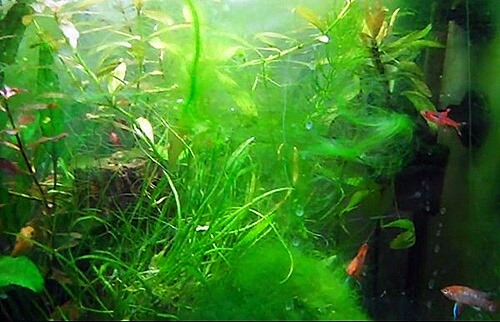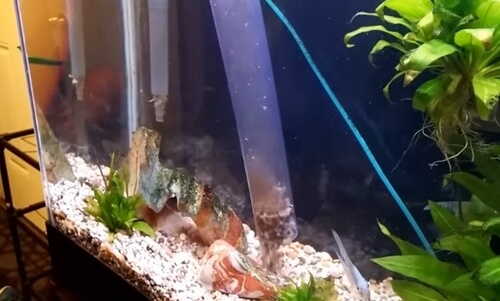Products recommended in this post contain affiliate links. If you buy something through our posts, we may receive a commission at no extra charge to you. See our full disclosures here.
Algae usually appears if you have an imbalance in nutrients, water circulation, CO2, oxygen and light. Too many nutrients and too little CO2 may cause algae to appear. However, too much light but not enough nutrients and CO2 may also cause algae. Many hobbyists think that lowering nitrates and phosphates (which are nutrients) will reduce algae outbreaks, when algae actually thrives in a low-nutrient environment.
Below are the main reasons why algae appears.
1. Not enough beneficial bacteria in a brand new setup

Algae typically appears in the first couple of months of a new setup. It is because a newly established planted aquarium does not have enough beneficial bacteria to transform ammonia with the nitrification cycle. The overabundance of ammonia may cause algae blooms because algae spores eat ammonia before they become algae. Algae covers most part of the plants, blocking light and depriving the nutrients of plants. Plants could eventually die.
The most effective way to prevent algae to overgrow in early stages of a brand new planted tank setup is to cycle the tank in a proper way. Using substrates that contain live microorganisms like Eco Complete and Activ-Flora aqua soils helps to boost this procedure. Besides, you can do some additional methods to reduce algae growth including:
- Using hardy algae eaters for new tank setups like Amano shrimps,
- Frequent water changes,
- Scraping off the algae on the glass surface with an algae magnet cleaner,
- Draw out the algae with an aquarium gravel vacuum cleaner.
2. Insufficient water circulation

To guarantee the nutrients and CO2 circulate through the aquarium and reach all of the plants, it is important to have strong waterflow and drainage. The flow rate should be five to eight times the aquarium volume. Select a filter system with the proper flow rate or supplement it with circulation pumps. When plants have adequate access to the nutrients and CO2, they leave little remaining in the water column for algae to use.
3. Insufficient surface agitation
Plants inhale CO2 only if the lighting is on and start using oxygen when the lighting is switched off. At these times and there’s insufficient oxygen within the system, plants, fish and beneficial bacteria fight for the dwindling oxygen. The first to suffer is the beneficial bacteria, which will die off, leading to increased ammonia and, eventually, algae blooms. Thus the right oxygen level is as important as CO2 supply.
Surface agitation will prove to add oxygen somewhere and can prevent surface scum from forming. However, an excessive amount of surface agitation may also off-gas the injected CO2. I recommend the use of an air pump to supply surface agitation, only once the lights are turned off.
Throughout the summer when temperatures are higher, beneficial bacteria activity increases and uses more oxygen. It is very important to increase surface agitation when temperatures rise.
4. Imbalanced light levels, CO2 concentration and nutrients
The rate where plants absorb CO2 and nutrients depends upon the amount of light provided. The more light, the more CO2 and nutrients plants need. In most cases, we provide an excessive amount of light but don’t measure the CO2 concentration and nutrient availability, and frequently, we haven’t supplied enough of either. At these times, algae blooms will appear. Ensure that you look at the water chemistry when the lights are switched on and when they’re turned off. This will give you an idea of whether you have to increase or decrease your CO2 and nutrient dosing.
As a rule of thumb, we wish to acquire a pH of 6.4 and kH of 4 to get the maximum CO2 concentration of 30ppm. NO3 and PO4 can be dosed daily to achieve the best possible concentration of 30ppm and 2ppm respectively.
You may like: how to use a drop checker to measure CO2 concentration in a planted tank?
5. Improper maintenance of aquarium substrate, filter and plants

Cleaning the substrate with a gravel vacuum cleaner
If this regular maintenance is ignored, organic matter begins to build up within the substrate and filter media. Regular light substrate vacuuming and cleaning of the filter media will decrease accumulated organic matter, which could clog the system and increase ammonia. Light vacuuming will also aerate the substrate, which helps plant roots get oxygen, as well as helps beneficial bacteria convert ammonia to the nitrate that becomes food for the plants.
Decaying leaves generate ammonia. Trimming plants and removing dead leaves will get rid of the ammonia source and promote new growth.
A consistent water change of 10-15% each week is encouraged.
Read more: How to easily change aquarium water and clean the algae?
6. Not enough shrimps, algae-eating fish or snails

Nerite snail
Introduce enough shrimps and snails, such as Nerite snails because this snail never breed in freshwater planted aquarium.
Trumpet snails are helpful in aerating the substrate. However, they have a tendency to multiply rapidly so be sure you keep their population manageable.

So-called “sucker fish” like otocinclus, small baby plecos or ancistrus are extremely proficient at cleaning diatoms and algae from plant leaves, decorative stones and driftwood. If you decide to get plecos or ancistrus, be sure to rehome them appropriately once they become too large for the system.
True Siamese algae eaters are also effective in removing black beard algae and hair algae. However, they can grow to a sized more than 14cm and can become very aggressive towards other fish, so that they are not right for all aquarium setups.
Top Editor's Choice on Fertilizer Tablets For Aquatic Plants
[amazon bestseller="Fertilizer Tablets For Aquatic Plants" filterby="price" filter="30" filter_compare="more" filter="available" orderby="percentage_saved" order="desc" template="list" items="10" tracking_id="tnk0c-aawp-cro-b-20"]Subscribe to our Newsletter!
Join our mailing list to receive the latest tips and news of our blog.

